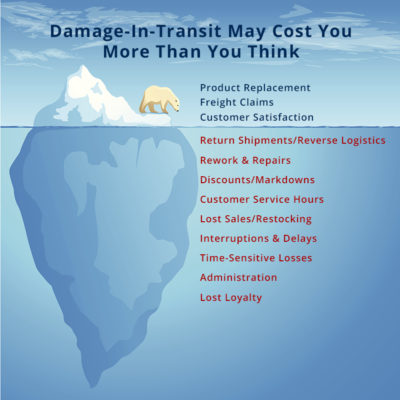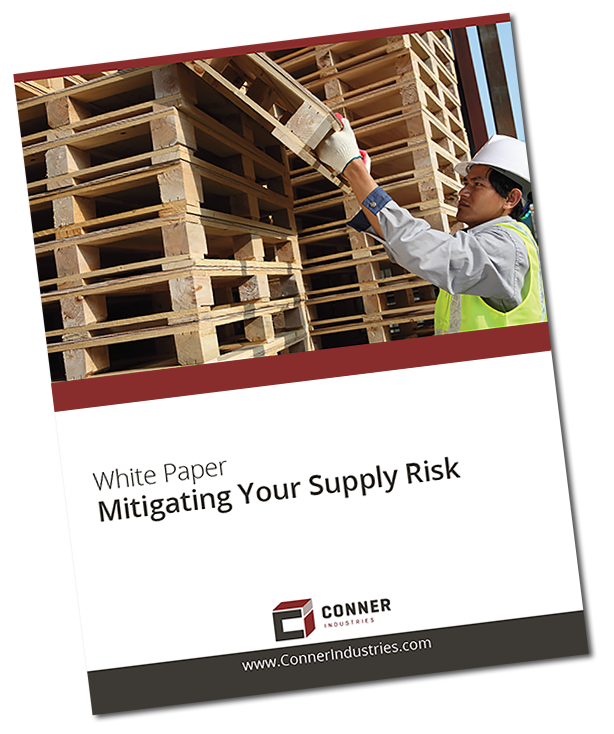
Understanding the True Cost of In-Transit Damage
Have you considered the true impact of in-transit damage on your company’s bottom line? In-transit damage can often be a silent killer of profitability for manufacturers. Though it is often overlooked, the consequences of damaged products during transit can reverberate throughout the entire supply chain, impacting businesses both financially and operationally.
Packaging Digest reports that up to 11% of unit loads arriving at distribution centers suffer some degree of damage. While this may be viewed as a logistical issue, the root cause frequently lies in packaging design, material handling protocols, or storage methods, long before transportation is even in the picture.
Supply chain managers want to protect products from any potential transportation damage because they know that it hurts their own profit margin. Unfortunately, many of these managers do not fully understand the full scope of repercussions of damaged products. In-transit damage costs American businesses 0.5% of gross sales. That equates to about $1 billion a year of damage losses in the United States alone!
What are the Measurable Costs of In-Transit Damage?
The process of calculating fixed damage costs can be meticulous but yields invaluable insights. To accurately gauge the true toll of in-transit damage, it’s crucial to encompass all associated expenses. This comprehensive approach facilitates the calculation of the business cost per damaged unit, which will give you insight that is unique to your company and supply chain.

Here are some factors to take into consideration before calculating your fixed damage costs:
– Sale price, foregone profit, and initial shipping expenses per unit.
– Replacement unit, any offered discounts, repackaging, and return freight costs.
– Administrative outlays, including customer service and insurance claim processing.
– Expenses related to inspecting and testing returned units for potential resale.
– Costs incurred for storing and disposing of returned units, encompassing warehouse space and opportunity costs.
– Loss of profit from discounted resale of returned units and the portion unsalvageable for resale or parts.
Once you have all these factors, you can determine the total product cost of damage per unit. Take the number you get from each scenario above and multiply it by the average number of units that are damaged in a given year. That will give you the total damaged product costs to your company and where you match up with the United States average. This number can also be used to see how much potential profit is being lost and why prevention is more cost-effective in the long run.
The Indirect Costs of In-Transit Damage
While some costs of in-transit damage cannot be easily seen, their effects reverberate throughout the organizational operations.
Lost Productivity
Dealing with damaged products and subsequent returns often disrupts workflow and productivity, with employees diverted from primary responsibilities to handle claims, coordinate returns, and manage replacements.
Employees can be more focused and productive in their jobs when not having to deal with damaged products or casing. The cost of productivity loss can be hard to quantify, but if it is happening regularly then the cost to productivity and your bottom line could be significant.
Fractured Relationships
In-transit damage jeopardizes customer relationships and satisfaction, potentially triggering production delays and financial penalties. The loss of trust from customers can lead to them finding other suppliers that they see as more reliable. Unfortunately, there are many ways that in-transit damage could fracture even your longest relationships. This is especially true in B2B relationships where your products are needed for the other business’ production. Receiving damaged goods could cause them to shut down their production line, and that can be a devastating fracture to your relationship.
With that situation, the company may not have the time to waste waiting on replacements. Depending on your contract with the customer, you may be held responsible for the production downtime and have to provide financial reimbursement. As already stated, this could cause them to not want to go through the hassle and find another supplier.
Damaged Sales & Brand Reputation
In-transit damage not only diminishes available inventory but also undermines sales efforts and tarnishes brand perception.
Products that are damaged in-transit could cause reduced available inventory, and that can lead to lost sales, lost market share, and a negative impact on brand image. No to mention, the precious time that is spent trying to rectify issues that the salespeople could be using to prospect and close new customers. When you want to gain new relationships and keep the ones you already have, it is essential to prevent in-transit damage.
Mitigating Your Risk
While numerous factors contribute to in-transit damage, effective protective packaging serves as the cornerstone for mitigation. Investing in an integrated packaging solution tailored to product specifications minimizes the risk of damage and ensures cost-effective operations.
Adopting a total cost approach to packaging empowers businesses to strike a balance between efficiency and affordability, accounting for in-transit damage alongside initial packaging expenses. By optimizing packaging solutions and considering factors like storage, handling, and transportation modes, companies can substantially reduce both the frequency and severity of in-transit damage incidents.
To Sum Up
The true cost of in-transit damage extends far beyond immediate financial losses, encompassing indirect expenses and enduring impacts on brand reputation and customer relations. Effective mitigation requires a holistic approach, prioritizing integrated packaging solutions aligned with organizational supply chain and organizational needs.



![[PRESS RELEASE] Conner Industries Expands Integrated Packaging Division with Acquisition of Kirkland Sales Inc.](https://connerpackaging.b-cdn.net/wp-content/uploads/2024/05/Foam-Page-Featured-500x383.jpg)







